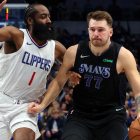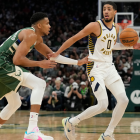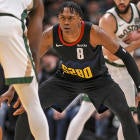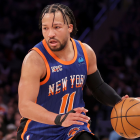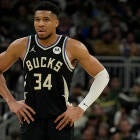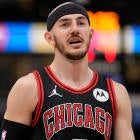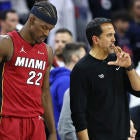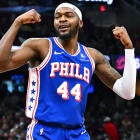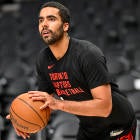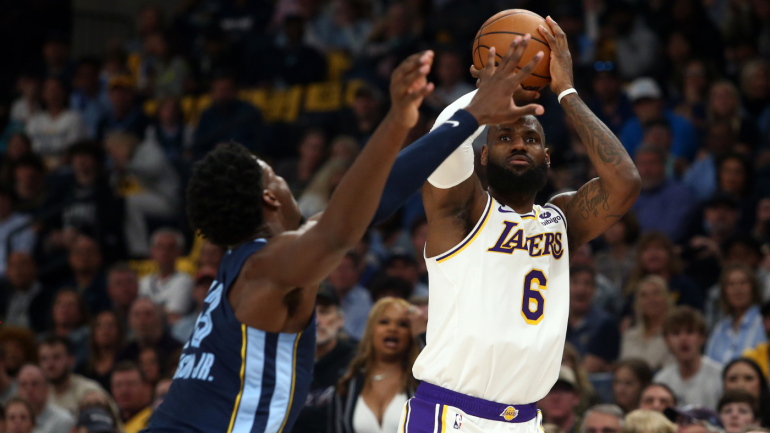
Those who doubt the Los Angeles Lakers as legitimate championship contenders consistently point out one potentially insurmountable flaw: shooting. Their historically poor offensive start to the season was based on their inability to score from distance. They shot 42-of-177 from deep in their miserable 0-5 start, and shooting by and large hasn't been a strength. They ended the season ranked 26th in 3-point attempts, 25th in 3-point percentage and 24th in made 3-pointers.
That's hardly the model for a successful LeBron James team. No shooting means no spacing. Without space, James needs to settle for jumpers himself. That's been a problem this season. He shot just 32.1% on 3's this season—his lowest mark in seven years—and wasn't much better on mid-range looks at 36.4%. The Laker offense relies on James scoring at the rim. He needs space to do that. Space isn't something opponents want to grant.
The raw numbers since the trade deadline have been better. With Russell Westbrook gone and D'Angelo Russell, Malik Beasley and Rui Hachimura in his place, the Lakers improved to 16th in 3-point percentage and 19th in 3-point attempts over the last two months of the season. The Memphis Grizzlies, it seems, were not impressed.
Their entire game-plan on Sunday revolved around over-helping at the basket in order to dare the Lakers to shoot jumpers. It worked for a good chunk of the game. The purple and gold were 5-of-20 from 3-point range midway through the third quarter. They proceeded to shoot 11-of-17 the rest of the way, and the Grizzlies did little to stop them. Case in point: the same schematic choice led to Rui Hachimura's first four 3-pointers.
Shot No. 1 starts out as a fairly standard play. D'Angelo Russell and Anthony Davis run a high pick-and-roll. Dillon Brooks follows Russell over the screen, but Xavier Tillman doesn't drop to cover Davis. He sticks with Russell as well knowing that Hachimura's man, Santi Aldama, will move into help position at the rim. This leave Ja Morant all alone to cover both Hachimura and Dennis Schroder. Russell sees Hachimura, and Schroder immediately knows what's happened and uses his positioning to set an impromptu screen on Morant while the pass in still in the air. That gives Hachimura the airspace he needs to swish the shot.
Shot No. 2 is a variation of the same play. Davis screens for Russell. Aldama drops to the nail to help. Russell finds Hachimura for three more points.
Now the Lakers are looking for this help. The third 3-pointer starts with a Schroder-James pick-and-roll The play breaks down and ends with James in the post. Jaren Jackson Jr. leaves Hachimura to double him. James passes it back to Hachimura for the bucket.
You know the drill by now. Schroder-James pick-and-roll. Jackson drops to the nail to help. Hachimura sinks his fourth 3-pointer of the third quarter.
The play of the night came about because the entire Memphis defense panicked on a single mismatch. With 4:21 remaining and the Lakers clinging to a two-point lead, they managed to get Anthony Davis matched up with Desmond Bane, who is not only half a foot shorter, but had five fouls at the time. Both Tyus Jones and Dillon Brooks see Bane's predicament and scamper over to try to force a pass. Davis sees the help immediately and makes a nice cross-court pass to Austin Reaves in the corner. Brooks flies by Reaves, who takes the clear lane to drive. Both Aldama and Jackson race Reaves to the rim, and he makes a flawless behind-the-back pass to Hachimura for his fifth 3-pointer.
Hachimura was hardly the only beneficiary. James, Reaves and Russell all took advantage of the Memphis game-plan, and the hotter the Lakers got, the more the Grizzlies seemed to double down. One could even argue that doing so is the right decision. Coaches tend to spook easily in the postseason, planning to leave shooters alone only to reverse course after a couple of clean 3-pointers. The law of averages says that eventually, those shots will stop going in. Shots at the rim aren't nearly as volatile. The Lakers win games at the rim. It wasn't necessarily a bad strategy.
It was just a somewhat outdated one. If those passes had gone to Russell Westbrook or Patrick Beverley or Juan Toscano-Anderson, the shots probably aren't falling. Rui Hachimura is not Klay Thompson. He's a 35% career 3-point shooter. But the Grizzlies treated him like a 25% shooter, never wavered, and lost the game as a result.
The Grizzlies probably aren't going to waver in Game 2. We're talking about an average shooting team, not a great one. Sometimes the open looks aren't going to fall. But over a series-long sample, the Lakers have improved enough to render "leave everyone wide open" a losing strategy.
And if that bears out over more than a single game, it's going to start showing in how opposing teams defend the Lakers. James took 16 shots in Game 1, and half of them came from behind the arc. That's a far cry from his playoff peak, when he could get to the rim at will. If he wants to overcome the help defense opponents throw at him near the basket, he's going to need some shooting help from his teammates. They delivered on Sunday, and if they keep it up, their opponents will have little choice but to give James the space he needs.














